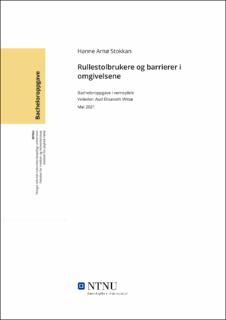| dc.contributor.advisor | Witsø, Aud Elisabeth | |
| dc.contributor.author | Stokkan, Hanne Arnø | |
| dc.date.accessioned | 2021-09-25T16:46:09Z | |
| dc.date.available | 2021-09-25T16:46:09Z | |
| dc.date.issued | 2021 | |
| dc.identifier | no.ntnu:inspera:81471222:34487302 | |
| dc.identifier.uri | https://hdl.handle.net/11250/2783493 | |
| dc.description.abstract | Tittel: Rullestolbrukere og barrierer i omgivelsene
Hensikt: Hensikten med denne oppgaven er besvare problemstillingen "hvordan kan barrierer i omgivelsene påvirke voksne rullestolbrukeres samfunnsdeltakelse?" For å belyse problemstillingen fra ulike perspektiver er det rettet fokus mot rullestolbrukeres egne erfaringer, samt hvordan vernepleieren kan bidra til en hverdag preget av samfunnsdeltakelse.
Metode: For å besvare oppgavens problemstilling er det benyttet litteraturstudie som metode. Det er samlet inn data som er grundig lest og analysert fra fem vitenskapelige og fagfellevurderte artikler.
Resultat: Resultatene til de fem artiklene har til felles at de peker på fysiske og holdningsbaserte barrierer som påvirker voksne rullestolbrukeres samfunnsdeltakelse. Artiklene retter også fokus mot hvilke psykiske skadevirkninger disse barrierene kan ha. Rullestolbrukere erfarer barrierer på daglig basis, men opplever til tross for dette forbedring i den universelle utformingen nå sammenlignet med tidligere år.
Konklusjon: Barrierer i omgivelsene kan påvirke voksne rullestolbrukeres samfunnsdeltakelse i høy grad. Dersom barrierene blir for overveldende kan de i verste fall medføre at den som opplever dem isolerer seg. Fysiske hindringer som mangel på rampe der hvor det er trapper medfører at rullestolbrukere ikke kommer seg inn i bygninger. Blikk og kommentarer fra andre medfører at de føler seg diskriminerte. Summen av disse medfører at deres forutsetninger for samfunnsdeltakelse ikke er på lik linje som resten av samfunnet.
Nøkkelord: voksne rullestolbrukere, nedsatt funksjonsevne, barrierer, universell utforming, samfunnsdeltakelse
Antall ord: 7700 | |
| dc.description.abstract | Title: Wheelchair-users and barriers in the surroundings
Purpose: The purpose of this task is to answer the issue of "how can barriers affect adult wheelchair-users participation in society?" In order to shed light on the issue from different perspectives, the focus is on wheelchair-users' own experiences, as well as how the health- and social worker can contribute to an everyday life characterized by community participation.
Method: The method of this task is a literature study. Data from five scientific and peer-reviewed articles has been collected and analyzed in order to answer the issue.
Result: The results of the five articles have in common that they point to physical and attitude-based barriers that affect adult wheelchair-users participation in society. The articles also focus on the psychological harmful effects of these barriers. Wheelchair users experience barriers on a daily basis despite improvement in the universal design.
Conclusion: Barriers in the environment can affect adult wheelchair users' participation in society. If the barriers become too overwhelming, they can in the worst case cause the person who experiences them to isolate themselves. Physical barriers such as lack of a ramp where there are stairs means that wheelchair users cannot enter buildings. Glances and comments from others make them feel discriminated against. The sum of these means that their preconditions for participation in society are not equal with the rest of society.
Keywords: adult wheelchair users, disabilities, barriers, universal design, community participation
Number of words: 7700 | |
| dc.language | nob | |
| dc.publisher | NTNU | |
| dc.title | Rullestolbrukere og barrierer i omgivelsene | |
| dc.type | Bachelor thesis | |
